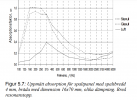Recently, I installed some acoustic panels in my listening room of the "slat wall" type, and I took the opportunity to make some before-and-after measurements. I'm posting it here as a service to the community, in case it is of interest.
For some background, I live in an apartment with an L-shaped living room as my listening room. The front wall is plaster/drywall, the back wall is concrete. Open on the left side, windows with curtains on the right side. I have a NAD M33 running Dirac Live. Two subs. The sound was quite good, but I had some issues with reverberation. Also, the speakers and my head are a bit too close to the walls, so there are - I assume - boundary effects in the 100-300 Hz region. This is what I wanted to fix.
Why slats? I first considered conventional acoustic absorbers from RPG, GIK, etc. Maybe mounted behind the speakers and behind the sofa where my listening position is. However, I was troubled by uncertainty about how effective they would be - at least in my use case. Besides, I find this kind of panels extremely ugly... Then somehow I came across slats. You can find a number of these slat panels on the internet, marketed as acoustic panels. Mine are from Fibrotech. The panels are 9 mm thick felt mats with slats in MDF glued on. A test sample I ordered looks like this:
View attachment 268873
Panels like this don't seem to be much discussed for audiophile purposes compared to conventional absorbers. The few discussions I have seen have been mixed. Anyway, even if they would not be as effective, they cover more wall - and look a lot better. So I figured that even if they would end up doing nothing for the acoustics they would look good enough to be worth it. Here is how my living room looks now:
View attachment 268874View attachment 268875
OK, enough talk, lets see some measurements. Here is a graph of the RT60 before and after (Topt is shown):
View attachment 268870
The only things that changed from before to after are the wall panels. The position of furniture, mic, etc. are essentially the same. Dirac Live was used with the exact same filters for comparison. As you can see, the region from about 300 Hz and upwards has significantly reduced decay time. Now it doesn't exceed much above 500 ms.
Here is the frequency response (both measurements are volume adjusted to roughly 75 dB on the REW SPL meter):
View attachment 268876
Unfortunately, the troublesome region from 100-300 Hz is still troublesome, or maybe slightly less so. I'll know more when I get around to re-running Dirac and do the sub integration again from scratch. (The response looks somewhat bass heavy, but actually it doesn't sound as bad as it looks.)
And here are left and right speaker ETC curves:
View attachment 268877View attachment 268878
So how does it sound subjectively? First of all the level of sound is lower. I need to turn up the volume a bit to play at the same perceived level. This makes sense to me, because some sound energy is removed by the absorption. Second, reverberation is perceivably lower. I would subjectively describe it as being "closer to the music" - especially for vocals. This also makes sense, I guess, since reverberation may be associated with large rooms, thereby distance. Finally, I think I can hear more details now, like in drumming and other "rapid impulse bursts". The first two of these effects, I feel certain to pick out in a blind test - the third, I *think* I would, but I don't know.
To conclude, I'm very happy with my new slat wall panels. They look good, and I think they solved at least some of my acoustic problems. They may be slightly less effective than conventional absorbers, but they work. My impression is that they are not highly regarded by audiophiles, but I really don't understand why. I think at least they should be in the toolbox.
OK, that's it. I hope this was useful.




